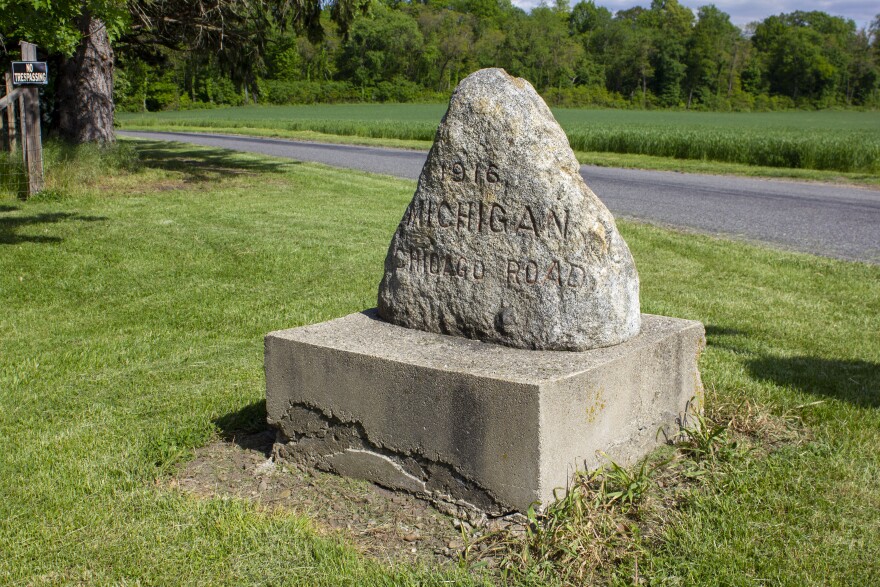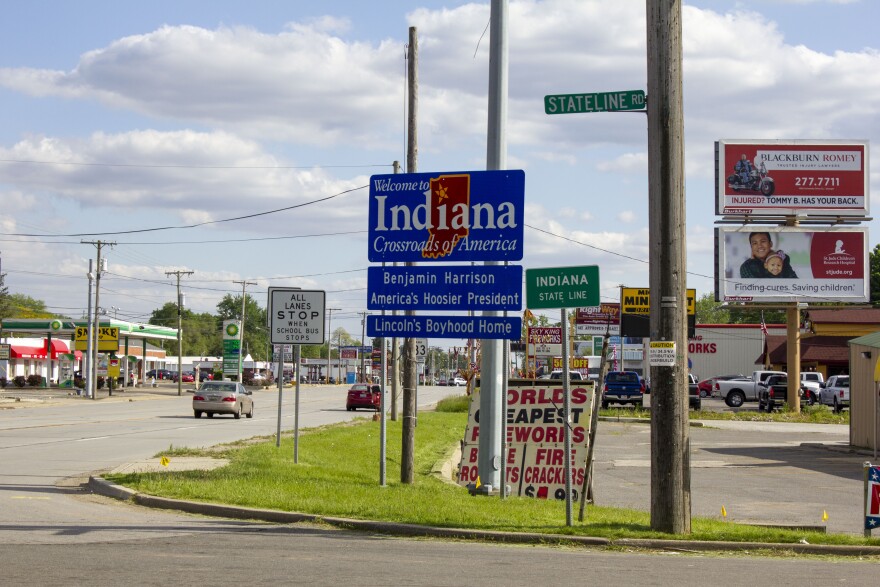Borders are important, but the one between Indiana and Michigan is a bit unclear. It was last surveyed in 1827, and it’s been so long that both states don’t really know anymore exactly where it is. But a new land survey seeks to change that once and for all.
Jack Owens is a semi-retired surveyor who’s been advocating for a modern retracing of the Indiana-Michigan border for 20 years. According to him, the fuzziness is a result of “benign neglect.”
“I call it the quiet border, because nothing ever comes up,” Owens said.
In contrast, Michigan’s other two borders have been controversial. In 1835, the territory nearly went to war with Ohio over control of the Toledo Strip.
The dispute was resolved by Congress a year later, with Toledo going to Ohio. In exchange, Michigan got statehood with most of the Upper Peninsula thrown in as a consolation prize.
In 1926 — almost one century later — Michigan and Wisconsin went to the Supreme Court to settle a border dispute on the Upper Peninsula.
Owens said because of those past controversies, both borders were surveyed again in the early 1900s with “durable monuments.”
“On the Ohio line, they set granite posts. On the Wisconsin line, they set concrete posts,” Owens said. “You can go find it if you want to look for it, you can find these markers.”
But the Michigan-Indiana border has never gotten the same treatment. It was last marked out in 1827, before Michigan was even a state.
At the time, Owens said, surveyors used a special compass and 66-foot chain. The team placed wooden posts every mile to mark the border and recorded the locations using two “reference trees” and any notable topographic features like lakes or streams.
“I’ll just tell you from experience — all those wood posts are rotted away, you know, they just decayed,” Owens said. “So, they’re very hard to find.”
Owens said later county surveys in the 1800s for things like determining property and township lines seem to have found some of the original markers. In addition, much of the current border area is marked by fences or strands of trees — but the exact location is unclear.
“Everybody’s got an idea of where it is,” Owens said. “It’s just if you had to know exactly, we can't tell you.”

He first learned of the issue in 2002 and got a group of surveyors together to try and solve the problem. They would take time off of work a couple times a year and go out and look for particular mileposts.
Owens said the group found five or six, but it quickly became obvious that at that rate, “it was going to take 200 years.”
Berrien County Surveyor John Kamer was part of that group. He says one of the reasons a modern border survey is needed is because back in 1827, surveyors could not be as accurate as they are today due to their equipment and the terrain.
To illustrate, he pulled out a record of an 1885 survey done to determine property lines on some land near Lake Michigan.
While not along the state border, county surveyor Elbert Drew still went through quite a lot, battling 25-foot-deep sand drifts and rough terrain thickly filled with trees.
“‘And therefore, I depended entirely on the needle for my course,’ which would have been his staff compass,” Kamer said. “What he should have been doing is perpetuating, kind of leapfrogging that line along, but he couldn’t see back from one to the other to push it forward.”
In the notes, Drew also offered some advice for future surveyors.
“And then he says, ‘If it ever becomes necessary to resurvey this section, let me advise the man who undertakes it to get his life insured before he undertakes it, especially in the west half,’” Kamer said.
Kamer said the group originally hoped they could re-survey the state line themselves — “just like any other boundary survey” — as many were licensed in both states.
But since most of the original markers are gone, it can only be done through the Supreme Court or the respective state legislatures. So, they began lobbying.
And their efforts paid off — Indiana approved legislation to create a state boundary commission in 2009, and Michigan followed suit in 2011.
But Kamer said funding for the surveys never got off the ground due to the recession and the commissions eventually dissolved.
“They also thought it was going to cost more than what was budgeted,” Kamer said. “I guess maybe that was a big factor.”
Now, there’s a renewed push. On May 19, Gov. Gretchen Whitmer signed a pair of bills into law that re-establish Michigan’s border commission. Indiana enacted a similar law in 2019, and both states plan to appropriate $500,000 towards the efforts.
Like last time, the commissions are made up of the five county surveyors from each state’s five border counties. They’re tasked with hiring a company to conduct a modern survey of the border.
Using a mix of modern technology like GPS along with the 1827 notes, the survey will look for the locations of the original markers and set permanent mileposts to give an exact picture of where the border is.
Once that’s complete, both commissions will review the results and send the findings to their respective state legislatures to approve the new boundary.
Kamer said the Indiana commission has gotten a head start — they’ve already hired a company and began surveying parts of the state line.
“They’re waiting for us, the Michigan side, to come join them — which is what we would like to do,” Kamer said.
But when it’s all said and done, any potential differences will not be massive. In places where the border is off, it’s likely by only a few feet or a few inches — most likely not entire houses, and definitely not whole towns.
And since the area is mostly rural farmland and it’s generally known where the border is already, why even bother doing this?
“If it isn’t your property line, you know, it’s kind of like the attitude is ‘so what?’” Kamer said.
There have been a few issues in the past, Kamer said, with things like traffic tickets and car accidents on roads that follow the state line.
And in the South Bend area, there are some subdivisions — and potential new developments — that directly touch the border, which could theoretically cause issues.
So, he said doing the survey now is a way of being proactive. Even though it’s taken almost 200 years, it’s better to have the matter settled before a problem arises.
“When it’s your line, and especially if there’s a problem, then it’s very important,” Kamer said. “I mean, when I was doing a lot of private practice, people would come in and fight over inches.”
So even if it’s just a few inches, Kamer said people should care about a properly surveyed state border as a matter of state sovereignty.
“It’s important because it’s our line,” Kamer said. “It’s Michigan’s line.”
The Michigan commission has until Jan. 1, 2026, to complete its work. Indiana’s commission expires on July 1, 2025.

